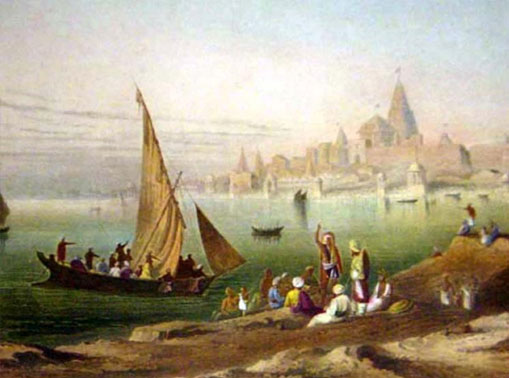Dwarka Nagari – Little History
 According to Hindu tradition still extant, the earliest known conqueror of Okhamandal was Shri Krishna, called also Ranchodji, the eight incaranation of Vishnu, Who after his seventeenth battle with Jara Sangh, king of Magadh Desh, fled from Mathura, and eventually arrived with his army at Okhamandal which he subjected after a hard struggle with the Kalas. Shri Krishna established his capital at Dwarka on the bank of the Gomti Creek.
According to Hindu tradition still extant, the earliest known conqueror of Okhamandal was Shri Krishna, called also Ranchodji, the eight incaranation of Vishnu, Who after his seventeenth battle with Jara Sangh, king of Magadh Desh, fled from Mathura, and eventually arrived with his army at Okhamandal which he subjected after a hard struggle with the Kalas. Shri Krishna established his capital at Dwarka on the bank of the Gomti Creek.
Krishna was succeeded by the great grandson of Vajranabh, who enjoys the saintly reputation of having built the present temple Dwarkanath, called also Trilok sundar, signifying ‘the handsomest of the three world’ Many Hindus religiously believe that the temple was erected in one night by supernatural agency, under Vajranabh’s direction.
Certain it is that whole of western and south-western Saurashtra, now included in a Jamnagar and Junaghadh districts was colonized by the Yadavas, whose most important leader was Shri Krishna. The Yadavas ruled and when they perished in a family quarrel under the influence of drink, and after Shri Krishna’s death Dwarka submerged under the sea. In this region the original in habitants are said to Kabas, Modas and Kalas, The Kabas and Modas now seem to be extinct but the present day Vaghers are said to have descended from the Kabas.
The Kalas re-conquered Okhamandal in the 2nd Century A.D next a Syrian Sukkur Belium conquered this region and during this time Dwarka submerged by the sea. He was driven out by another Syrian named Mehem Guduka. Again Kalas now know as Vaghers.
It was 13th century when the Rathods came and took advantage of the Herule-chavada quarrels. The few surviving chavadas and Herules were absorbed by the Vaghers. Veravalji, the Rathod now became the sole ruler of Okhamandal. During the periods of Bhimji, Mahmud Begada who was sultan of Gujarat, conquered Okhamandal destroying the temple at Dwarka. Later the Vaghers drove out the Muslim.
The history of Okhamandal upto 1800 seems to be uneventful but since this date, until their final extermination or submission the Vadhelas and Vaghers came up repetedly against to the British and the Gaikwads.
1807 A.D.
Col. Walker was ordered to proceed to Okhamandal, imposed fine Rs.110000.
1816 A.D.
Col. East, reduced fine restored the District to the Gaikwads.
1845-47A.D.
Rebellions broke out at least twice because the Gaikwad administration was weak.British The deputed Lient Barton for the settlement.*
1868 A.D
The Vaghers convinced by time under the Gaikwads, Okhamandal formed a part of Amreli district.
1947 A.D.
After Independence Okhamandal became part of the Baroda state.
1949 A.D.
Baroda, of which Okhamandal formed a part, merged in Bombay state.
1949 A.D.
Okhamandal was then made part of Amreli district.
1959 A.D.
It was transferred to Jamnagar district and made one of its talukas.
1961 A.D.
1st May: Bombay state was again divided and Gujarat state was formed and became a part of Gujarat state.
* Even after stationing a British officer at Dwarka, Mulu Manek and Deva Manek continued their deeds of outlays so major Reynolds had once again set out against them.
